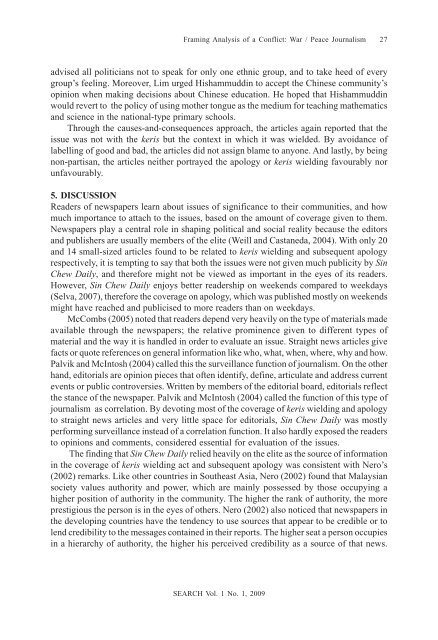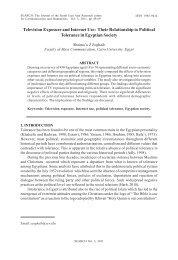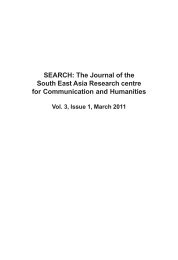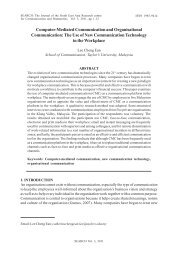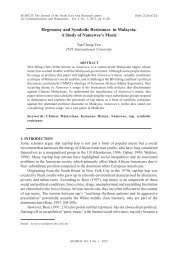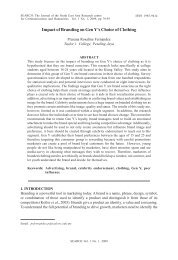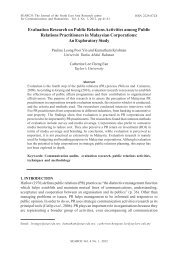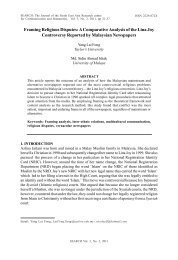Framing Analysis of a Conflict: War/Peace Journalism - Nicole Yang ...
Framing Analysis of a Conflict: War/Peace Journalism - Nicole Yang ...
Framing Analysis of a Conflict: War/Peace Journalism - Nicole Yang ...
- No tags were found...
You also want an ePaper? Increase the reach of your titles
YUMPU automatically turns print PDFs into web optimized ePapers that Google loves.
<strong>Framing</strong> <strong>Analysis</strong> <strong>of</strong> a <strong>Conflict</strong>: <strong>War</strong> / <strong>Peace</strong> <strong>Journalism</strong> 27advised all politicians not to speak for only one ethnic group, and to take heed <strong>of</strong> everygroup’s feeling. Moreover, Lim urged Hishammuddin to accept the Chinese community’sopinion when making decisions about Chinese education. He hoped that Hishammuddinwould revert to the policy <strong>of</strong> using mother tongue as the medium for teaching mathematicsand science in the national-type primary schools.Through the causes-and-consequences approach, the articles again reported that theissue was not with the keris but the context in which it was wielded. By avoidance <strong>of</strong>labelling <strong>of</strong> good and bad, the articles did not assign blame to anyone. And lastly, by beingnon-partisan, the articles neither portrayed the apology or keris wielding favourably norunfavourably.5. DISCUSSIONReaders <strong>of</strong> newspapers learn about issues <strong>of</strong> significance to their communities, and howmuch importance to attach to the issues, based on the amount <strong>of</strong> coverage given to them.Newspapers play a central role in shaping political and social reality because the editorsand publishers are usually members <strong>of</strong> the elite (Weill and Castaneda, 2004). With only 20and 14 small-sized articles found to be related to keris wielding and subsequent apologyrespectively, it is tempting to say that both the issues were not given much publicity by SinChew Daily, and therefore might not be viewed as important in the eyes <strong>of</strong> its readers.However, Sin Chew Daily enjoys better readership on weekends compared to weekdays(Selva, 2007), therefore the coverage on apology, which was published mostly on weekendsmight have reached and publicised to more readers than on weekdays.McCombs (2005) noted that readers depend very heavily on the type <strong>of</strong> materials madeavailable through the newspapers; the relative prominence given to different types <strong>of</strong>material and the way it is handled in order to evaluate an issue. Straight news articles givefacts or quote references on general information like who, what, when, where, why and how.Palvik and McIntosh (2004) called this the surveillance function <strong>of</strong> journalism. On the otherhand, editorials are opinion pieces that <strong>of</strong>ten identify, define, articulate and address currentevents or public controversies. Written by members <strong>of</strong> the editorial board, editorials reflectthe stance <strong>of</strong> the newspaper. Palvik and McIntosh (2004) called the function <strong>of</strong> this type <strong>of</strong>journalism as correlation. By devoting most <strong>of</strong> the coverage <strong>of</strong> keris wielding and apologyto straight news articles and very little space for editorials, Sin Chew Daily was mostlyperforming surveillance instead <strong>of</strong> a correlation function. It also hardly exposed the readersto opinions and comments, considered essential for evaluation <strong>of</strong> the issues.The finding that Sin Chew Daily relied heavily on the elite as the source <strong>of</strong> informationin the coverage <strong>of</strong> keris wielding act and subsequent apology was consistent with Nero’s(2002) remarks. Like other countries in Southeast Asia, Nero (2002) found that Malaysiansociety values authority and power, which are mainly possessed by those occupying ahigher position <strong>of</strong> authority in the community. The higher the rank <strong>of</strong> authority, the moreprestigious the person is in the eyes <strong>of</strong> others. Nero (2002) also noticed that newspapers inthe developing countries have the tendency to use sources that appear to be credible or tolend credibility to the messages contained in their reports. The higher seat a person occupiesin a hierarchy <strong>of</strong> authority, the higher his perceived credibility as a source <strong>of</strong> that news.SEARCH Vol. 1 No. 1, 2009


